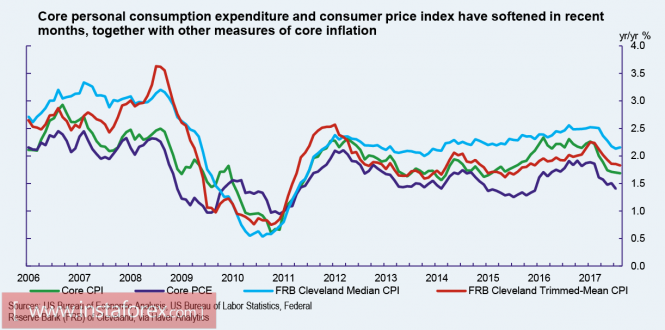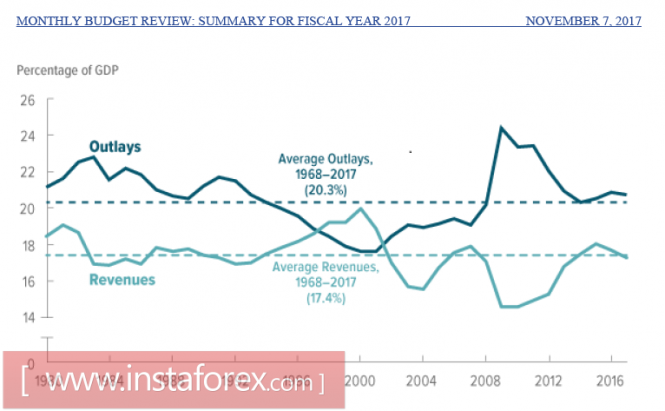The dollar ended the week with a slight decline, for the first time in a month. The decline is primarily due to market reaction towards the tax reform plan proposed on Thursday. The final document was slightly worse than market expectations, based on preliminary statements by Trump and Treasury Minister Mnuchin, and could also reduce the attractiveness of the US stock market as a result.
At the same time, the tax reform aims to increase the attractiveness of U.S. assets, promote the repatriation of capital and revitalize business activity. These measures are necessary against the backdrop of weak growth rates of real incomes of the population. As the drop in consumer demand intensifies deflationary pressure and can lead to yet another wave of recession in the near future.
Slowing inflation in the US - this is currently the most important threat to the plans of the government and the Fed. Since January 2017, the main consumption expenditure has lost about 0.5% in price, similar rates of core inflation, calculated by an alternative method, have similar rates of slowing down.

Such a decline is almost entirely the result of the fall in prices for basic services, which accounts for about 0.45 percentage points, but for basic goods - it is only 0.05 percentage points. This includes the decline in demand for financial services, lower prices in the telecommunications sector, medicine and housing prices.
At the same time, employment reached its peak, the jobless rate fell to 4.1% in October, its further decline is almost impossible, the growth rates of creating new jobs is expected to slow down. On the labor market, there is a struggle not for quantitative indicators, but for qualitative indicators, that is, for changing the structure of employment in favor of full-time jobs and with fairly high qualifications. It is entirely uncertain whether this task will be solved. Therefore, the expectations of a rise in the average wage might not be realized. Accordingly, the main condition for the growth of inflation, namely, the increase in real incomes of the population - is under threat.
In order to eliminate this concern and to provide an answer to the call for tax reform. The Senate began to consider changes in legislation proposed by the Ministry of Finance. A strong decrease in the tax burden is an attempt to raise real incomes of the population and improve effective demand. However, it also brings forward another problem - a sharp increase in the budget deficit.
The U.S. House Committee on the Budget summed up the results of the 2017 financial year, which ended on September 30. The results - the growth of the budget deficit reached 666 billion dollars, or 3.5% of the US GDP, an increase from 3.2% a year earlier.

Income from income taxes, the largest source of budget revenues, grew by 3%, and from the wage fund (social insurance) - by 4%, while revenues from corporate profits declined. At the same time, budget spending grew by about 3%, the trend is steady. In October, the deficit stood at 62 billion, which is 27% higher than in October 2016.
In other words, the growth of revenues from the two main sources of budget filling did not decrease, but instead had raised the deficit. What will happen if the implementation of the tax reform begins simultaneously with the tightening of the financial conditions held by the Fed?
Income to the budget will significantly drop from all the main sources of income, while at the same time the cost of servicing the public debt will increase, and on defense - at least not be reduced. Such consequences of the ongoing reforms will accelerate the growth of the budget deficit, the rate of this growth will be much higher than the figures set in the baseline scenario of the NWE, according to which by 2027, the annual budget deficit may reach 1.5 trillion dollars.
Basically, the Trump administration will be forced to sharply raise borrowing, that is, the growth rate of the national debt will increase with the outstripping growth of expenses for its servicing. Needless to say, this prospect will not attract investors, but instead frighten them away.
All these factors cast doubt on the growth rates of demand for the dollar. The upcoming week will be quite saturated with macroeconomic statements, primarily on the data of consumer and production prices in October. The release of data that is worse than the September indices can cause a wave of selling for the dollar and will cast doubt on the general trend reversal in favor of the US currency.
The material has been provided by InstaForex Company - www.instaforex.com